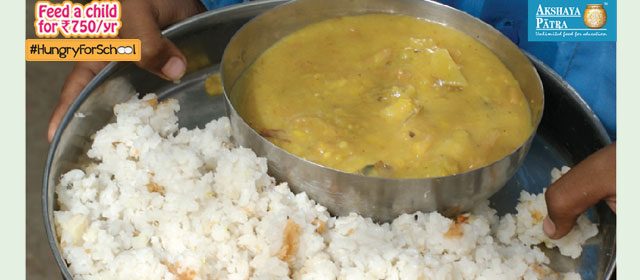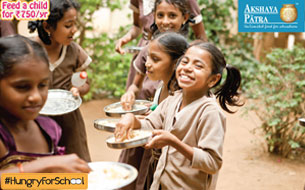Ever wondered how Akshaya Patra decides what is right for its beneficiaries? Here is the answer.
The Akshaya Patra Foundation works towards providing the right kind of food to the children with guidance from the Government. After much discussion and research, we decide the daily menu for the children. Below are excerpts from an interview with our nutrition specialist at the Foundation.
1. How is the right quantity of nutrients determined for each child?
The right quantity of nutrients for each child has been determined as per the National Programme of Mid Day Meal in Schools (MDMS) specified by the government of India.
As per their age group, certain norms are set pertaining to nutrition. A cooked midday meal should primarily provide 450 calories and 12 gm of protein to a child in the age group of 6-10 years. A child who is about 11 to 15 years of age needs a total of 700 Calories and 20 gm of Protein. These meals should also include micro nutrients like Iron, Folic Acid, Vitamin A and so on, in adequate quantities.
2. What are the top nutrients each child needs and how is Akshaya Patra ensuring they get these?
Children require different kinds of nutrients but most important are energy, protein, folic acid, vitamin A, iron, calcium and zinc.
The Akshaya Patra recipes contain different food groups (cereals, pulses, vegetables, spices, sugar and jaggery, edible oil and more) to ensure an adequate supply of nutrients.
The recipes are standardised by calculating nutritive values referring the NIN guidelines (nutritive value for Indians as per the National institute of Nutrition ICMR Hyderabad) and our recipes are verified through external lab analysis.
3. How is the quality standard of raw material maintained while procuring for the mid-day meal?
The quality of raw materials is ensured by Supplier Quality Management Programmes. The raw material specifications are circulated to suppliers to ensure they deliver good quality raw materials. The raw materials are thoroughly checked by the TAPF quality team before accepting them for use in the kitchen.
The raw materials need to meet the FSSAI (Food Safety and Standards Authority of India) and AGMARK specifications. They are stored following proper storage practices and are utilised as per FIFO (First In First Out) FEFO (First Expiry First Out).
4. What are the health benefits of providing good nutrition?
It helps in overall growth and development of the body and helps to prevent micronutrient deficiencies such as anaemia, vitamin A deficiency and so on. Good nutrition is also scientifically proven to aid the cognitive development of growing children, a factor vital towards helping children succeed in school.
5. Has there been a marked difference in the health of children consuming the mid-day meal (physically and mentally)?
Yes, sufficient intake of the meals has helped and continues to help in the overall development of children belonging to underprivileged sections of the society. It has also helped curb issues like malnutrition, mortality rates, stunted mental and physical growth in underserved children.
The mid-day meal has helped eradicate classroom hunger. Children are now able to concentrate in the classroom and there is an increased participation in extracurricular activities as well.











